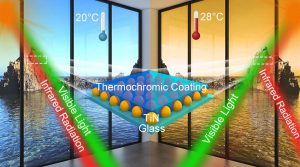Thermochromic smart coatings are a clever means to control solar radiation subject to temperature changes. These coatings block infrared radiation (IR) at high temperatures while allowing it to go through at low ones.
In this context, vanadium dioxide (VO2) is one of the promising thermochromic materials due to its reversible phase transition and high efficiency in modulating IR transmittance. However, its high transition temperature at 68 °C has hitherto not allowed its use in room-temperature applications. Although significant efforts have been devoted to lower the transition temperature by reducing the VO2 size grain, introducing elemental doping or adopting the substrates appropriately, issues such as structure instability or undesired variations in the spectral response have hindered the fabrication of coating with good visible transmittance and thermochromic performance at temperatures between 20-30 °C.
To overcome these limitations, in their recent work published in Advanced Materials, Prof. Chu’s group at City University of Hong Kong fabricated a hybrid thermocrhomic system by integrating VO2 coatings with plasmonic titanium nitride nanoarrays (VO2/TiN).
Using the titanium nitride as a local heating source that converts irradiation into heat, they manage to accelerate the phase transition of the system. When properly excited by illumination, this smart coating blocks 70% of the IR radiation at 28 °C while showing good IR transparency at 20 °C. More importantly, the coating can intelligently control the IR transmittance depending on the irradiation intensity and ambient temperature.
According to the researchers, “The strategy can be generally employed with other nanotechniques to further improve the thermochromic performance of smart coatings. These advantages make the plasmonic thermochromic coating promising as an intelligent air conditioner without energy cost.”

















